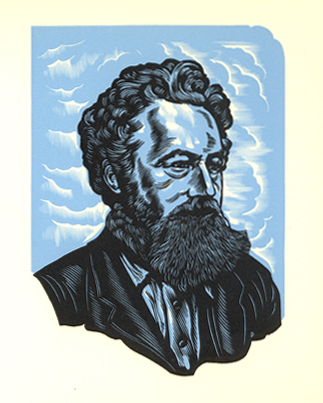By Lilia Walsh

A wood-engraved portrait of Morris by John Depol, from the book William Morris Master-Printer by Frank Colebrook.
William Morris was a designer of stained glass, tapestries, wallpaper, chintzes, furniture, books, and typefaces. He was also a preservationist, socialist, poet, novelist, lecturer, calligrapher, translator of classic Icelandic and early English sagas, and founder of the Kelmscott press. He was born in 1834, and died at 62 in 1896, due to (according to his physician); “simply being William Morris, and having done more work than most ten men.” Morris became involved with socialist causes in the late 1870s. He found it impossible to separate esthetic issues from social and political ones, to him social reform was simply an extension of his arts and crafts production.
I originally came to the Archives and Rare books library as an intern working on the libraries’ William Morris collection. My responsibility was to create an annotated bibliography of all holdings of the library directly produced by, about, or stylistically related to William Morris and his work. I also created a web exhibit detailing Morris’ life, work, and effect on later movements in print design and private press.
The web exhibit and annotated bibliography can be accessed here:
http://www.libraries.uc.edu/libraries/arb/exhibits/William%20Morris/index.html
While working on the project, I wrote a transcription and annotation of a letter Morris wrote to his friend Aglaia Coronio on October 24th, 1872. This letter is one of the most unique items in the ARB William Morris collection, and I got in contact with Florence Boos at the Journal of William Morris Studies to see if she would be interested in an article on the letter.
She instead asked me to write an article for the William Morris Newsletter about the collection at UC, and my experience working on the project. It was a great exercise to reflect on the project, and when the article went out to both the US and European William Morris societies, it was exciting to receive feedback from the UK and Germany.
Read the article here:
http://www.morrissociety.org/newsletter.pdf
What has been truly remarkable about working on this project is seeing how far the influence of one person can stretch. During his life, Morris was incredibly prolific; with his hand in everything from tapestry design, architecture, writing, translation, socialist causes, historic preservation, wallpaper design, book design, printing, and fishing. In addition to the work Morris completed in his lifetime, he had an impact on his contemporaries and those who came after him that was truly astounding. While not all of the printers I catalogued in my project personally enjoyed Morris’ work, it was undeniable that they were part of a movement of renewed interest in the craft and process of printing that Morris had been instrumental in beginning. In addition to printing history, Morris’s mark can be seen extensively in the pattern design and industrial design of the last one hundred years.
I have learned a great deal about the arts and crafts movement and printing history through doing this project and I hope that my project will make this remarkable collection more accessible and useful to patrons and classes at the university.
